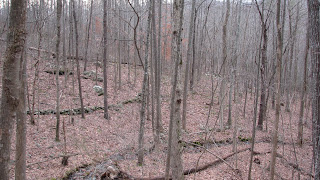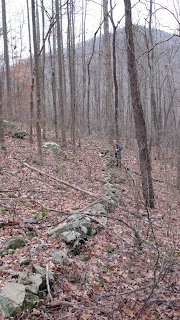Here are some additional images from around 9UN367, a very rich and intriguing site:
1_Wall13.jpg: Prehistoric wall in middle left of image, as seen from adjacent hillside. I believe this wall corresponds with Wall 13 in the Loubser and Frink paper. There are additional stone features at middle right.
 2_Wall13.jpg: Closer view of Wall 13, with intrepid explorer Kevin Scallions. Track Rock Gap petroglyph site is at base of peak in background.
2_Wall13.jpg: Closer view of Wall 13, with intrepid explorer Kevin Scallions. Track Rock Gap petroglyph site is at base of peak in background.
 3_largeCairn.jpg: Large stone cairn at 9UN367, south of Wall 13, with life-size dummy provided for size comparison.
3_largeCairn.jpg: Large stone cairn at 9UN367, south of Wall 13, with life-size dummy provided for size comparison.
 4_stonecircle.jpg: Stone circle or collapsed cairn at 9UN367, with additional linear features in background.
4_stonecircle.jpg: Stone circle or collapsed cairn at 9UN367, with additional linear features in background.
 2_Wall13.jpg: Closer view of Wall 13, with intrepid explorer Kevin Scallions. Track Rock Gap petroglyph site is at base of peak in background.
2_Wall13.jpg: Closer view of Wall 13, with intrepid explorer Kevin Scallions. Track Rock Gap petroglyph site is at base of peak in background. 3_largeCairn.jpg: Large stone cairn at 9UN367, south of Wall 13, with life-size dummy provided for size comparison.
3_largeCairn.jpg: Large stone cairn at 9UN367, south of Wall 13, with life-size dummy provided for size comparison. 4_stonecircle.jpg: Stone circle or collapsed cairn at 9UN367, with additional linear features in background.
4_stonecircle.jpg: Stone circle or collapsed cairn at 9UN367, with additional linear features in background.
5_nearLgCairn.jpg: Kevin Scallions at stone features near large cairn.
 6_Wall13.jpg: Another image of Wall 13, one of many linear features at this site.
6_Wall13.jpg: Another image of Wall 13, one of many linear features at this site.
 6_Wall13.jpg: Another image of Wall 13, one of many linear features at this site.
6_Wall13.jpg: Another image of Wall 13, one of many linear features at this site.I would like to point out that far from suggesting a "Mayan" connection for the features at this site, the Loubser and Frink paper says "Bearing in mind that 9UN367 is located at the headwaters of the Tennessee Valley it might have closer ties with the Tennessee and Kentucky area than with the Georgia area to the south."
...By the way, thanks for introducing me to Tommy Hudson a few weeks ago. We've had some interesting conversations.

8 comments :
I love that first picture, it really gives a sense of the place. It also is so reminiscent of scenes I see here in New England. Similarly the #4 ("Stone circle or collapsed cairn") is a good old rectangular mound with hollow, of pretty much the usual dimension - which I call "Wachusett Tradition". So, are the Nipmuc [a local tribe whose ancestors may have built the mounds around here] the remnants of refugee Mayans? I would like to hear the Nipmuc creation myth.
Personally I believe the arrowhead style of the Mississipians, which is very similar to the Mayan arrowhead style, did not make it to New England. But I am happy to think some other aspects of the Pan American AD ~900 culture did.
The photos of the stone rows remind me of those in the post
http://rockpiles.blogspot.com/2011/12/stone-lined-springs-short-stretches-of.html
And isn't Maize or Corn an import from Meso-America???
Ed Lenick suggests that the widespread Turtle Creation Story of the NE has lots to do with petroglyphs and other turtle imagery: http://books.google.com/books?id=ZKBHqkzoGWEC&pg=PA147&lpg=PA147&dq=new+england+Indians+Creation+story&source=bl&ots=YyMlWLgDRN&sig=28IAfmzJAVgBNo7r-KAsyfRmSu8&hl=en&sa=X&ei=_3v8TsieBtGhtwfxqcS7Cg&ved=0CC4Q6AEwAzgU#
Good point about the corn. Very good point. This is a corn culture isn't it? Maybe that is a central idea.
I hope folks get a chance to look at Norman Muller's interesting and highly credible comments on Track Rock Gap from yesterday:
http://rockpiles.blogspot.com/2011/12/some-history-of-rock-pile-studies-in.html
Although there are some intriguing similarities between southeastern Mississippian cultures and the much earlier Meso-American cultures, the "boots-on-the-ground" experience of these researchers seems to bear out an indigenous origin for these features, consistent with others in the area.
Tobacco, too, like corn, is a tropical plant that was brought in trade from Mexico or southern.
(later) To reply to Geophile and Tim. Imagine those plants spreading into New England along with a mound burial concept.
But I guess the timing is wrong. Corn was more like 0 AD - right?
Post a Comment